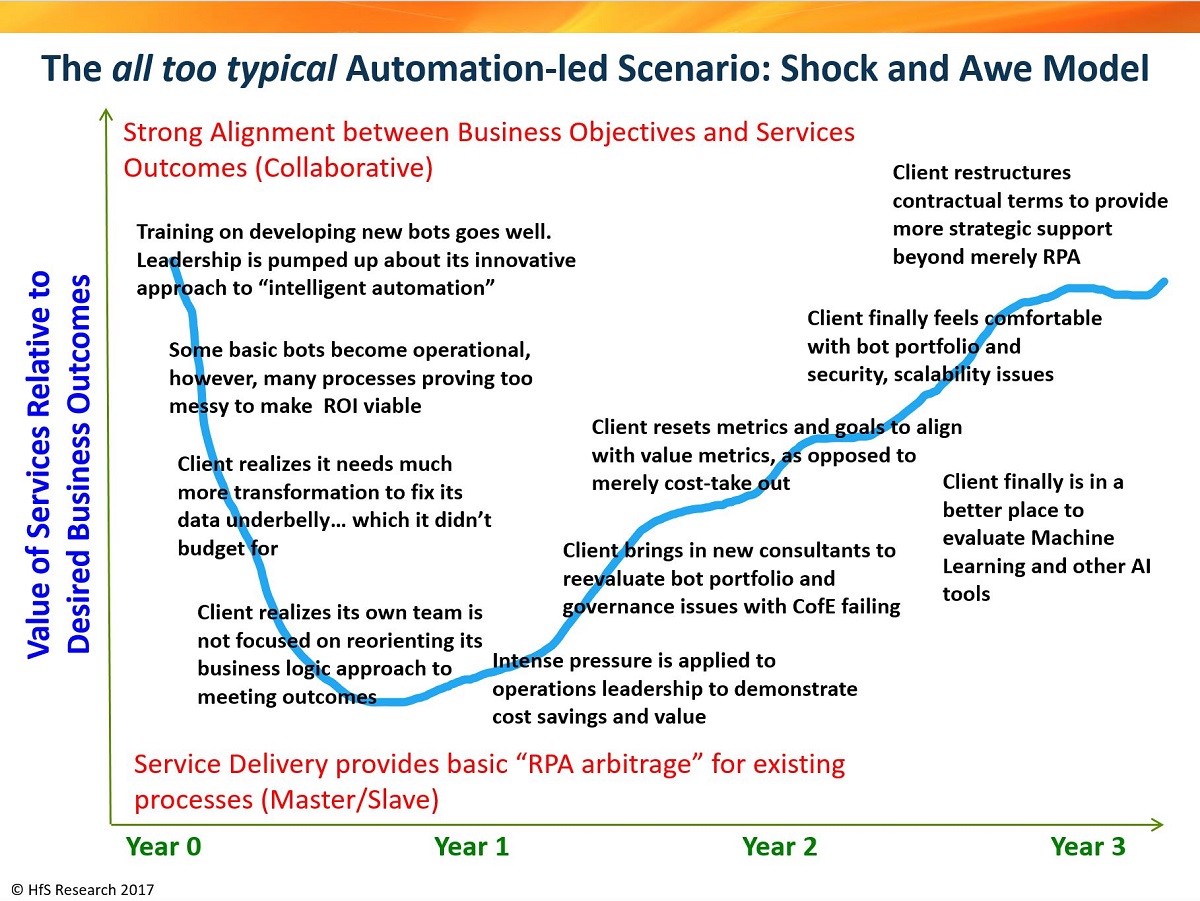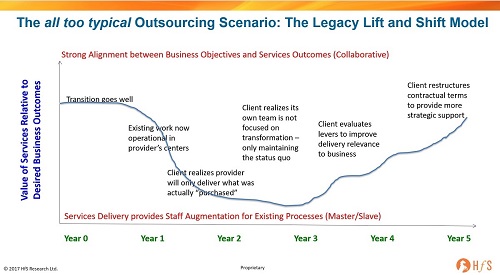
Isn’t it amazing how history has this habit of repeating itself? Especially when it comes to services engagements, where the buyer hopes to shed loads of cost and the providers hope to make a handsome profit, while building a utility model to resell similar engagements to many other buyers.
And that is what we’re seeing, as the services industry evolves from engagements deriving value from lower wage costs to one which combines lower wages with the RPA arbitrage of repetitive tasks being computerized in software recording devices. As one analyst firm once famously declared exactly five years ago: “Welcome to Robotistan, Outsourcing’s Cheapest New Destination“. Or is it?
The difference these days, is that many of the emerging services engagements are being based more on hope than certainty, where many buyers (often naively) think this is going to be just as easy as lumping the work offshore, and many providers simply have little choice but to sell them the dream, and live through the hell with them, if they want to stay relevant in this market. How else can you build an effective automation-led services model, if you don’t have the guinea pig clients to join you on that nice packaged holiday to Robotistan… And, let’s face it, how else are both buyers and providers supposed to behave, when there are so few historical benchmarks to set baseline metrics that both parties know are achievable? Yes people, welcome to the era of Shock and Awe automation deals… it’s the only way.
So let’s skim over the first phase of RPA: The discovery phase: “What is RPA?”, “Do I use AA, BP or UiPath?”, and “This stuff is easy, let’s just PoC it by ourselves”. And don’t forget the “Our attempts at CofEs always fail, but this time will be different because we’ve learned from our outsourcing and shared services experiences”. Let’s begin the new automation-led journey at the phase where they’ve selected their products, appointed the CofE lead, and signed a deal with a service provider daring to escort them to the pearly gates of Robotistan:
The issues that are starting to unravel in this robotic age, is the simple fact that most clients avoided the painful transformation to their data processes and people, during their earlier efforts to source work to lower cost global locations. They were pretty much able to delight their CFOs with 30%+ savings, without having to do much to change their underlying process architectures (the old “lift, shift then transform” approach usually stopped after the “shift”). The reality of moving into an automation arbitrage environment is that you can’t just replicate that work into an even cheaper robotic environment without really figuring out how to do this effectively.
Bot licenses are not cheap, and simply do not make financial sense for a lot of processes, the way they are currently being operated. You can simply end up paying $8K a year for a bot that only is utilized for 20 minutes a day, when you could streamline that process into a broader workflow and use that same bot to process a lot more work for the same cost. Looking at several engagements already in place, clients are committing to significant staff reduction within 12-24 month of contract signing, and many are quickly realizing they are facing some serious complications if they are going to meet the metrics their CFOs are expecting. Either they end up running operations on desperately thin staff numbers, or they own up that they need to rethink that they need a significant transformation on their data infrastructures, processes and people culture, if they are going to enjoy the delightful fruits of Robotistan. As several early RPA adopters will already tell you: You need to do MDM before you RPA.
When you talk to some of the leading consultancies in this space, they will tell you that they are making more of their revenues on pre-implementation transformation work, just getting clients into a place where they can do this. They will also tell you the issues are not about the technology, but much more about the change management necessary to deploy the technology effectively.
The Bottom-line: The early RPA adopters are doing everyone else a huge favor by writing the new rulebook
The biggest issue facing the services industry today is that we have run out of silver bullets, BandAids and scapegoats. In order to get to Robotistan, you need to finally look deeply into your underbelly of messy processes, spaghetti code, manual workarounds and other funky ways of handling exceptions. Moreover, you need to look at your people and figure out how to foster a culture of inclusion and innovation. Most enterprises have been stagnating for years, but as the guinea pigs find their way through their shock and awe of having to conduct real surgery – and psychotherapy – on themselves, a new rulebook that guides us through the steps we have to take to learn, think, calculate and act, will emerge that many of the laggards will gleefully follow.
Posted in : Robotic Process Automation








This stuff is easy, just POC it, you can record it in days, you should be doing this quickly, you can buy licenses for just the tasks you need to automate- that is serious smoke pushed out in the RPA market.
Whilst I agree change management is necessary to make existing processes automation-ready and to deploy the technology effectively is a key issue, there is an undeniable technology issue as well here.
A lot of the technology and the approach to adopt RPA is sold as a silver bullet, but the easy stuff is going to make the situation worse over the months as it is outdated or unfit for such purposes.
Automating business processes is complex stuff, requiring a lot of due diligence, designing, development and testing. It needs to be done efficiently and not quickly in a rush, as that will create an enormous risk for adopting businesses.
Back in the old days, there was a saying for this: “Your mess for less…”.
It would be a shame indeed if RPA merely ends up being cost arbitrage on steroids, instead of an actual opportunity to clean up the underbellies of hodge-podge, sub-par processes.
This is a great article Phil. LIKE.
I subscribe to simplification and automation. Commonly, focus will only be on driving costs down, instead of also looking for ways to drive value up. If your RPA method doesn’t result in more simple, elegant processes that deliver better a customer experience, you are not doing it right. Even better when we can take away pain for the user too.
Ensure the bots are making human work easier and let’s not automate waste.
Food for thought for many a buying organisation, thanks Phil. Coordinated lean, data, RPA, AI, technology and people transformation…. Great cat.
@Eric: The similaries are frightening!

PF
Excellent perspective! The lack of operational change management and addressing the people-side of automation is limiting the benefits to be realized.
Jon: So how would you re-engineer and simplify your process by automation if the tooling and approach for RPA being sold takes you away from doing just that and instead forces you to record up what you have as existing by making a pitch that you should be doing this quickly than in a pragmatic way? Once automated the process would anyways be 2-3 times faster.
Deepak –
Agree basic recording can still make it faster Deepak but it also automates the waste and delays. We find some steps can be simplified or even eliminated using lean thinking and tackling the issues in the article. BluePrism is also very effective RPA software because it’s object based. Easier to change and improve than basic recording applications.
Jon
They actually are frighteningly similar. I guess everyday a sucker is born and the deeper pockets they’ve got the better. Its just that the mousetrap design change but the mouse and the trap remain the same.
I agree with Jon on the front and want to add that one of crucial step in the automation journey of any firm is to select the right processes that should be automated. If this step is not executed tightly it can make your wall fall. Consulting firms typically push the client to select as many processes as they can eventually resulting in higher costs at a later stage.
Regards
Abhishek Kapoor
In the earlier ERP era, many companies completed a BPR exercise alongwith ERP implementation. A strong process re-engineering coupled with RPA tools will provide a good ROI for RPA implementation. At Datamatics, we have our own RPA suite and provide both implementation services and a cost effective BOT licenses.